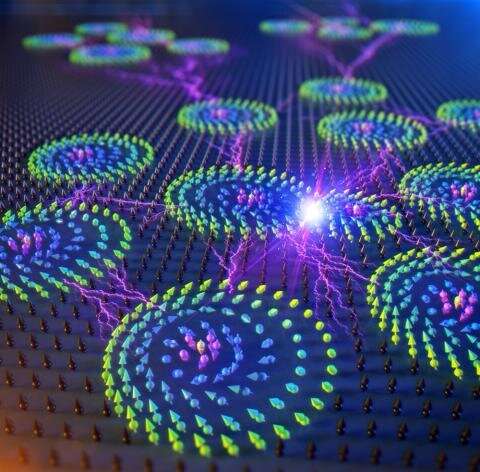Skyrmions are a type of quasiparticle with properties that could lead to the next generation of data storage and transfer. Ames Laboratory recently gained great insight into these structures, but scientists are still trying to understand the dynamics of their formation. Ames Laboratory recently discovered a never-before-seen characteristic of skyrmions, which can divide like biological cells. The insight could lead to better control and manipulation of skyrmions, which could help guide the design for high density and energy efficient data storage and transfer devices. Credit: Ames Laboratory
Scientists at the U.S. Department of Energy's Ames Laboratory have discovered that skyrmions— a type of quasiparticle with properties that could lead to the next generation of data storage and transfer— reproduce by splitting in a way very similar to biological cell division.
Skyrmions are nanoscale magnetic vortices, a type of quasiparticle that are driven by ultra-low electrical current. As a quasiparticle, they have no real mass, yet form a periodic pattern very similar to the symmetrical arrangement of atoms inside a crystal, or crystal lattice.
"In order to integrate skyrmions into future devices, science must have an accurate understanding of their formation mechanism" said Lin Zhou, a scientist who employs cutting-edge microscopy techniques for measuring local magnetic properties in materials at Ames Laboratory's Sensitive Instrument Facility. "In this research, we directly proved that skyrmion crystal grows from a conical magnetic phase in the same way as real nanocrystals grow from solution."
Unlike those real crystal structures, however, the skyrmions can annihilate imperfections in the lattice pattern by self-splitting (similar to cell reproduction), a kind of self-healing process that has never been described before.
To understand the physics that control the growth mechanism the team observed, the scientists combined micromagnetic simulation with a string method to investigate the interaction force and transition pathways between various spin states.
"We found that there is a competitive repulsive and attractive interactions force between skyrmions in the cone phase that governs the particle-like skyrmion lattice growth." said Liqin Ke, a scientist at Ames Laboratory. "And, we found that the self-splitting mechanism is more energetically favorable than nucleation and growth of a new skyrmion inside the defective lattice."
Zhou said the insight could lead to better control and manipulation of skyrmions, which could help guide the design for high density and energy efficient data storage and transfer devices.
The research is further discussed in the paper, "Mechanisms of Skyrmion and Skyrmion Crystal Formation from the Conical Phase," published in Nano Letters.
More information: Tae-Hoon Kim et al. Mechanisms of Skyrmion and Skyrmion Crystal Formation from the Conical Phase, Nano Letters (2020). DOI: 10.1021/acs.nanolett.0c00080
Journal information: Nano Letters
Provided by Ames Laboratory
























